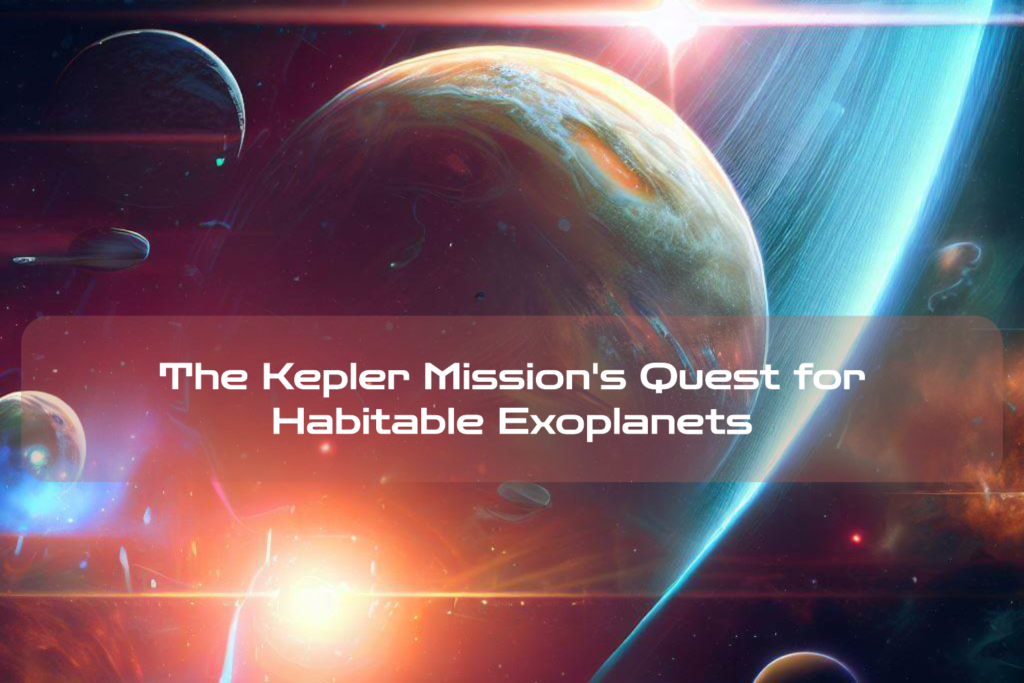Looking for Homes Beyond Our Solar System
As humans, we have always been fascinated with the concept of life beyond our planet. From Sci-fi movies to conspiracy theories, we’ve explored every avenue possible in an attempt to understand what might be out there in the great expanse that is outer space.
While we may not yet have definitive proof of extraterrestrial life, recent discoveries made by astronomers and space experts alike are bringing us closer than ever before. The search for habitable exoplanets is a crucial part of this journey.
The Kepler Mission: A Key Player in the Search
The Kepler Space Telescope was launched on March 7th, 2009, with one primary goal: to search for earth-like planets that orbit stars other than our Sun. By using powerful technology known as transit photometry, which measures light changes from distant stars as planets pass across them, Kepler has already made several groundbreaking discoveries. The mission was named after Johannes Kepler; a German astronomer who discovered the laws governing planetary motion.
Since its launch nearly 14 years ago, Kepler has identified thousands of exoplanets within our galaxy alone, and it continues to make new discoveries even today despite having retired back in 2018. It’s safe to say that without this game-changing mission, we may never have been able to fully appreciate just how vast and diverse our universe truly is.
What Makes Habitable Exoplanets So Important?
Although discovering any new planet beyond our solar system is exciting news on its own, what really matters most is finding those which could potentially support life – habitable exoplanets- as they are often referred to by astronomers. With over 4,000 confirmed exoplanet discoveries made so far by various missions, including NASA’s TESS and the aforementioned Kepler mission, this search for habitable worlds has gained even greater momentum in recent years. The hope is that through these discoveries, we can expand our understanding of what it means to be alive in the universe and uncover new insights into how life could potentially evolve beyond our own planet.
What are Exoplanets?

Exoplanets, or extrasolar planets, are planets that orbit stars outside our solar system. These planets can range in size from smaller than Earth to larger than Jupiter and can be found at different distances from their host stars. Exoplanets were first discovered in 1995 by Swiss astronomers Michel Mayor and Didier Queloz, and since then, thousands of exoplanets have been confirmed.
Definition and Characteristics of Exoplanets
Exoplanets are defined as planets that orbit a star outside our solar system. They can be classified into several categories based on their characteristics, such as size, composition, and distance from their host star.
For instance, some exoplanets are rocky like Earth, while others are gaseous like Jupiter. Furthermore, exoplanets can be categorized based on their proximity to the habitable zone around their host star.
The habitable zone is the region around a star where conditions may be suitable for life as we know it to exist. Planets located in this region may have surface temperatures that allow liquid water to exist, which is essential for life.
Importance of Studying Exoplanets in the Search for Habitable Worlds
Studying exoplanets is crucial in the search for habitable worlds beyond our solar system. Understanding the properties of exoplanet atmospheres and surfaces can give us insight into what makes a planet habitable – not everything that seems similar to Earth may actually harbour life-supporting environments. Moreover, by studying exoplanet systems, we can learn more about how planetary systems form and evolve over time, which gives us a better understanding of the origins of our own Solar System.
Discovering exoplanets has revolutionized our understanding of the universe and opened up new avenues for exploring other worlds beyond our own. With advancements in technology and future missions, we may soon find the holy grail of exoplanet research – a habitable planet beyond our own solar system.
The Kepler Mission

Overview of the Kepler spacecraft and its mission objectives
The Kepler spacecraft was launched by NASA in 2009 with the primary objective of finding exoplanets that are in or near the habitable zone of their host stars. The spacecraft was named after Johannes Kepler, who discovered the laws of planetary motion.
The mission was designed to survey a specific region of the Milky Way galaxy, looking for stars that have planets orbiting around them. The Kepler spacecraft has an impressive design, featuring a large, photometer that is capable of detecting minute changes in brightness from distant stars.
This photometer is so sensitive that it can detect a 20-parts-per-million decrease in brightness caused by a planet passing in front of its host star. This allows scientists to detect exoplanets based on how they transit (pass in front) their host star.
How the Kepler mission detects exoplanets through transit photometry
The transit method is used to detect exoplanets by observing how they pass in front of their host star and cause a temporary dip or reduction in brightness from our perspective. The time between these dips can give us an idea of how long it takes for the planet to orbit around its host star.
Additionally, by studying changes in light as the planet transits across its star’s surface, astronomers can also gather information about its size and distance from its parent star. To accomplish this detection method, the telescope must stare at a single area for an extended period—usually at least three years—to be able to capture enough transits to confirm if there is an exoplanet present around each observed star.
This approach allows scientists to identify potentially habitable worlds and determine their characteristics, such as size, mass, and distance from their parent stars. Overall, the combination of precise instrumentation and careful observation used during this mission has allowed us to make huge advances in our understanding of the universe and the potential for life beyond our solar system.
Discoveries from the Kepler Mission

Number of Exoplanet Discoveries Made by Kepler
The Kepler mission has been a game-changer in the search for exoplanets, having found over 4,000 confirmed exoplanets as of 2021. That’s an incredible number when you consider that before Kepler launched in 2009, we only knew of a few dozen exoplanets.
The vast amount of data collected by Kepler allowed scientists to identify thousands of exoplanet candidates and confirm their discoveries through follow-up observations.
Characteristics of Notable Exoplanet Discoveries
The discoveries made by the Kepler mission have been incredibly diverse and have significantly contributed to our understanding of exoplanets.
Some notable discoveries include:
– Kepler-452b: This planet is often referred to as “Earth 2.0” because it is very similar in size and orbit to Earth and receives a similar amount of energy from its star.
– TRAPPIST-1 System: This system contains seven Earth-sized planets that orbit a cool red dwarf star, making them potential candidates for being habitable.
– K2-18b: This planet is located within its star’s habitable zone, where temperatures could support liquid water on its surface.
These discoveries have led scientists to believe that there could be billions of potentially habitable planets throughout our galaxy alone. While more research is needed to confirm these findings and determine if life exists on any of these planets, the discoveries made by Kepler have certainly opened up new avenues for exploration beyond our solar system.
The Challenges of Finding Habitable Exoplanets

So Far, Yet So Close: The Distance Factor
The search for habitable exoplanets is not an easy one. The first and perhaps most obvious challenge is the sheer distance between us and these potential new homes. The closest known exoplanet to our Solar System, Proxima Centauri b, is still over four light-years away from us.
This means that even if we could travel at the speed of light, it would take us four years to get there. To put this in perspective, the fastest spacecraft currently ever launched by humans, the Parker Solar Probe, travels at a maximum speed of 430,000 miles per hour.
At that speed, it would still take over 6 million years just to reach Proxima Centauri b! This vast distance means that we have to rely on remote sensing techniques like transit photometry and radial velocity measurements to detect exoplanets from afar.
The Limits of Our Technology
Another major challenge in finding habitable exoplanets is simply technological limitations. Even with our best telescopes and detectors, it can be difficult to discern whether a detected exoplanet really harbours life or not. For example, most current detection methods only give us information about an exoplanet’s size and distance from its star rather than its actual composition or atmospheric makeup.
This makes it challenging to determine whether a given planet might have a stable climate or contain the necessary elements for life as we know it. Additionally, many planets orbit close enough to their stars that their surfaces are bathed in intense radiation or heat that would make them inhospitable for life as we know it.
Overcoming Obstacles
Despite these challenges, scientists are hard at work developing new technologies and methods for detecting habitable exoplanets. Some promising new developments include the use of space-based telescopes and more advanced detection techniques like direct imaging and gravitational microlensing.
Additionally, many ongoing missions, like TESS and the James Webb Space Telescope (JWST) are designed specifically to search for habitable exoplanets. These missions will help expand our knowledge of the universe and bring us one step closer to answering one of the most fundamental questions in science: are we alone in the universe?
Future Missions in Exoplanet Research

New Frontiers
As the search for habitable exoplanets continues to evolve, new missions are being planned and launched. One of the most exciting of these missions is the Transiting Exoplanet Survey Satellite (TESS), a NASA mission that launched in 2018. TESS uses the same transit method as Kepler, but it will cover a much larger area of sky and focus on nearby stars.
This mission is expected to discover thousands of new exoplanets, many of which could be potentially habitable.
Another mission is the James Webb Space Telescope (JWST).
This telescope is capable of detecting and characterizing the atmospheres around exoplanets, which could provide important clues about their ability to support life. JWST also has a much larger mirror than its predecessor, Hubble, providing improved resolution and sensitivity.
Building on Kepler’s Discoveries
While Kepler has already made numerous groundbreaking discoveries, new missions are still heavily relying on its data to build upon these findings. For example, TESS will use Kepler’s findings to identify stars that are most likely to host exoplanets within their habitable zones.
One future mission with a clear connection to Kepler is the European Space Agency’s PLATO (Planetary Transits and Oscillations of Stars) mission, set for launch in 2026.
PLATO aims to expand upon Kepler’s work by observing brighter stars and using a more advanced instrument that can detect smaller planets than those discovered by Kepler.
The search for habitable exoplanets is an ongoing endeavour that promises continued discovery and innovation as scientists learn more about our universe beyond our solar system. With each new mission launched into space, we come closer to finding Earth-like planets orbiting other stars and ultimately learning more about the potential existence of life beyond our own planet.
Final Thoughts

The Importance of Discovering Habitable Planets
The search for habitable exoplanets is a remarkable journey and one that has been ongoing for decades. Finding planets beyond our solar system that could potentially support life is vital to understanding our place in the universe.
It is also critical to the future of human exploration of space and the possibility of colonizing other worlds. Given the finite resources on Earth, learning how to live sustainably on another planet could be essential for survival.
Kepler’s Contributions
The Kepler mission has been a major contributor to this search. The discoveries made by Kepler have led to an entirely new understanding of planetary systems and have shown us that other star systems can be quite different from our own. Kepler has taught us that there are many more planets out there than we ever imagined, and it has given us clues about what kinds of planets might support life.
Over its mission lifetime, Kepler discovered more than 4,000 exoplanet candidates – many with the potential for being habitable or located within their star’s habitable zone. Furthermore, through detailed observations and data analysis by scientists around the world, we have gained insights into their atmospheres, compositions, sizes and orbital characteristics.
Looking Forward
As scientists continue to discover more about exoplanets beyond our solar system – thanks in large part to missions like Kepler – it is clear that we still have much more to learn about these distant worlds. While challenges remain in finding truly habitable planets – such as those with stable atmospheres or liquid water on their surfaces – researchers will continue pushing forward with new missions aimed at discovering more about these mysterious objects. Despite these challenges, though, there remains much optimism among astronomers and astrobiologists alike when it comes to discovering potentially habitable worlds beyond our own star system.
With each new discovery and each new mission launched, there is a growing sense that our understanding of the universe and its potential for life is expanding. And that is indeed an exciting prospect.

C M, a seasoned editor, journalist, and consultant, is deeply fascinated by the convergence of technology, space, and the future of humanity.
With a particular interest in transhumanity, futurology, and the philosophical and ethical dimensions of these domains, C M serves as the lead contributor to SpaceSpotlight and TranscendSphere.
When not penning insightful articles on these rapidly evolving fields, C M indulges in their love for podcasts and books, proudly embracing their status as a ‘Happy Nerd Extraordinaire!’



